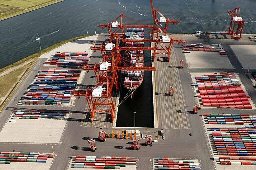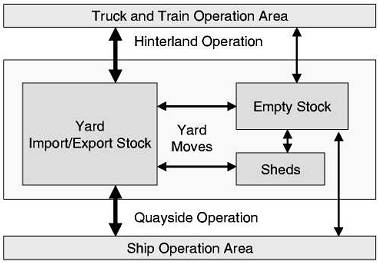- Trang chủ
- Container Terminal
Maritime container terminal
A maritime container terminal is a place where containers arriving by ocean vessels are transferred to inland carriers, such as trucks, trains, or canal barges and vice verse.
Generally, a terminal is a facility where cargo containers are transshipped between different transport vehicles, for onward transportation.
The transshipment may be between ships and land vehicles, for example trains or trucks, in which case the terminal is described as a maritime terminal. Alternatively the transshipment may be between land vehicles, typically between train and truck, in which case the terminal is described as an inland terminal.

Maritime container terminals tend to be part of a larger port, and the biggest terminals of this type can be found situated around major harbors. Inland terminals serving containers tend to be located in or near major cities, with good rail connections to maritime container terminals.
Functions
Every maritime terminal performs four basic functions: receiving, storage, staging, and loading for both import (entering the terminal by sea and usually leaving by land modes) and export (usually entering the terminal by land and leaving by sea modes) containers.
- Receiving involves container arrival at the terminal, either as an import or export, recording its arrival, retrieving relevant logistics data and adding it to the current inventory.
- Storage is the function of placing the container in a known and recorded location so it may be retrieved when it is needed.
- Staging is the function of preparing a container to leave the terminal. In other words the containers that are to be exported are identified and organized so as to optimize the loading process. Import containers follow similar processes, although staging is not always performed. An exception is a group of containers leaving the terminal via rail.
- Finally, the loading function involves placing the correct container on the ship, truck, or other mode of transportation. In this work the emphasis will be put on internal logistics chain of container terminal (i.e. vessel-truck-yard and opposite direction respectively).
Structure
In general logistics terms, container terminals can be described as open systems of material flow with two external interfaces. These interfaces aStructureIn general logistics terms, container terminals can be described as open systems of material flow with two external interfaces. These interfaces are the quayside with loading and unloading of ships, and the landside where containers are loaded and unloaded on/off trucks and trains. Containers are stored in stacks thus facilitating the decoupling of quayside and landside operation.re the quayside with loading and unloading of ships, and the land-side where containers are loaded and unloaded on/off trucks and trains. Containers are stored in stacks thus facilitating the decoupling of quayside and land-side operation.

Operation areas of a container terminal and flow of transports
Loading and discharging a ship
When a ship arrives at the port, the containers have to be taken off the ship. This is done by manned Quay Cranes (QCs), which take the containers from the ship's hold and the deck.
Next, the QCs put the containers on vehicles, like automated guided vehicles (AGVs). After receiving a container, the AGV moves to the stack. This stack consists of a number of lanes where containers can be stored for a certain period. These lanes are served by, for example, automatically controlled Automated Stacking Cranes (ASCs).
When an AGV arrives at a lane, the ASC takes the container off the AGV and stores it in the stack. After a certain period the containers are retrieved from the stack by the ASCs and transported by the AGVs to transportation modes such as barges, deep-sea ships, trucks or trains.
This process is also be executed in reverse order, to load containers on a ship.
For a clear idea of loading and unloading container ships at terminals,watch these videos
Top container ports
As of 2023, the world's top 10 container ports, along with their respective countries and throughput measured in twenty-foot equivalent units (TEU), are:
- Port of Shanghai, China: 49.0 million TEU
- Port of Singapore, Singapore: 39.0 million TEU
- Port of Ningbo-Zhoushan, China: 35.3 million TEU
- Port of Shenzhen, China: 26.9 million TEU
- Port of Qingdao, China: 26.4 million TEU
- Port of Busan, South Korea: 22.8 million TEU
- Port of Tianjin, China: 21.8 million TEU
- Port of Guangzhou, China: 20.8 million TEU
- Port of Hong Kong, China: 14.3 million TEU
- Port of Rotterdam, Netherlands: 13.4 million TEU
These figures highlight the significant role Asian ports, particularly those in China, play in global trade. The Port of Rotterdam stands out as the busiest port in Europe, ranking tenth worldwide.
Return from Maritime container terminal to Home Page
New! Comments
Have your say about what you just read! Leave me a comment in the box below.